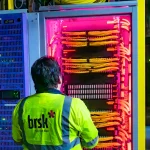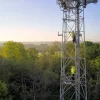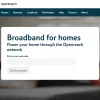Openreach Reveal UK Pilot Pricing for 3.3Gbps FTTP Home Broadband Tier

Network operator Openreach (BT) has this afternoon revealed the first pricing for their forthcoming pilot of XGS-PON based Fibre-to-the-Premises (FTTP) broadband ISP lines, which is due to get underway in March 2026. But for now they’re only revealing how much they’ll charge for the 3.3Gbps (3300Mbps) tier.
Just to recap. Openreach’s current full fibre service is largely still based off older Gigabit Passive Optical Network (GPON) technology, which places limitations on how fast they can go before capacity becomes an issue. For example, GPON supports a capacity on each trunk line of up to 2.5Gbps (Gigabits per second) downstream and 1.24Gbps upstream, which needs to be shared between several premises.
As a result, Openreach’s fastest asymmetric consumer broadband product via FTTP currently maxes out at a download speed of 1.8Gbps and uploads of 120Mbps (ISPs usually play it safe and promote this as c.1.6Gbps). However, rural areas covered by their government-funded Project Gigabit (Type C) roll-out contracts can separately access symmetric speeds, albeit only up to 1Gbps, and that’s priced more as a premium business product.
Advertisement
By comparison, the operator’s new XGS-PON technology can potentially handle speeds of up to 10Gbps (the ‘X’ stands for 10, the ‘G’ for Gigabits’ and the ‘S’ for Symmetric speed), which will help them to offer faster broadband speeds and be more competitive with rivals that already have faster tiers using similar upgrades. Consumers might not strictly need such speeds yet, but marketing departments can still use it.
Back in September 2025 ISPreview revealed (here) that Openreach were planning to trial XGS-PON technology in early 2026, which would reach about 40,000 premises in Guildford and push download speeds from ISPs up to a blistering 8.5Gbps (8,500Mbps). The new briefing gives us our first practical taste of that by setting out the pricing for their future 3.3Gbps tier, which will come with upload speeds of either 330Mbps or 3300Mbps (symmetric). This is ONLY for residential premises.
| Bandwidth | Pilot rental | Operative date |
| Up to 3300/330 Mbit/s | £324.00 p.a. | 01/03/2026 |
| Up to 3300/3300 Mbit/s | £360.00 p.a. | 01/03/2026 |
| Connection | Pilot charge | Operative date |
| Standard Connection | £122.84 | 01/03/2026 |
| Premium Connection | £152.84 | 01/03/2026 |
| Advanced Connection | £297.84 | 01/03/2026 |
| Standard Connection – XGS Box Swap | £0.00 | 01/03/2026 |
| Proactive FTTP Upgrades Connection Standand | £0.00 | 01/03/2026 |
| Proactive FTTP Upgrades Connection Premium | £30.00 | 01/03/2026 |
| Proactive FTTP Upgrades Connection Advanced | £175.00 | 01/03/2026 |
At £324 +vat per year (or £27 per month) this looks to be quite competitively priced. But it’s worth remembering that Openreach’s price only reflects the wholesale cost of the line, while retail ISPs still have to add all sorts of extra costs on top before getting to the price you pay (e.g. 20% VAT, network/service features, general costs/support, profit margin etc.).
Consumers in the trial area who already take an FTTP connection from Openreach will of course also need another quick engineer visit in order to upgrade the internal Optical Network Terminal (ONT) to one that supports XGS-PON. We’ve previously revealed details of the new ONTs they’ll be using to support this service (here).
Advertisement
The 8.5Gbps speed mentioned earlier is initially more about testing the capabilities of their new network to handle that performance than launching a commercial product at such speeds (i.e. we suspect it might not be given a price). But the planned future product speeds in their official documentation currently only go up to 3.3Gbps, which to be fair is absolutely fine – it’s still a very impressive performance level.
The classic catch with packages this fast is that most consumers would struggle to harness those top speeds, usually due to Wi-Fi/device limits and any limitations of the online servers you’re connecting with (Why Buying Gigabit Broadband Doesn’t Always Deliver). But if you’re happy to pay for it, why not. The rest of the internet will catch up eventually, and rivals already have faster tiers than 3.3Gbps.
At present it’s too early to identify which ISPs will be launching customer trials using the new 3.3Gbps tier, although EE (BT) were the first to do so when the prior 1.8Gbps tier first emerged. One of the biggest obstacles for other ISPs is that they often have to wait for the next layer of wholesale providers to begin offering circuits at such speeds before they can do the same and this often takes time.
Mark is a professional technology writer, IT consultant and computer engineer from Dorset (England), he also founded ISPreview in 1999 and enjoys analysing the latest telecoms and broadband developments. Find me on X (Twitter), Mastodon, Facebook, BlueSky, Threads.net and Linkedin.
« Full Fibre UK Broadband Connections Overtake FTTC for First Time
Advertisement
Leave a Reply Cancel reply
Privacy Notice: Please note that news comments are anonymous, which means that we do NOT require you to enter any real personal details to post a message and display names can be almost anything you like (provided they do not contain offensive language or impersonate a real person�s legal name). By clicking to submit a post you agree to storing your entries for comment content, display name, IP and email in our database, for as long as the post remains live.
Only the submitted name and comment will be displayed in public, while the rest will be kept private (we will never share this outside of ISPreview, regardless of whether the data is real or fake). This comment system uses submitted IP, email and website address data to spot abuse and spammers. All data is transferred via an encrypted (https secure) session.





















































Encouraging pricing, should allow ISPs to set retail pricing in line with what Sky can do on CityFibre
BT still peddling asymmetric speeds on XGS-PON instead of just symmetric at that speed point, laughable.
Wait, I thought the BT fan boys on here over the months were saying BT got it right with GPON and no business case for faster or for symmetric. Meanwhile the ALTNETS continue to eat into the customer base which is disguised by continuous roll out of FTTP to keep the figures up. Once the FTTP build is complete, and assuming no takeovers by likes of Vermin Media, it will be interesting to see the figures for the ALTNETS – I suspect the BT customer base will only go down forcing them to try and cut prices to try and oust the ALTNETS at that time…..
“ The classic catch with packages this fast is that most consumers would struggle to harness those top speeds, usually due to Wi-Fi/device limits and any limitations of the online servers you’re connecting with (Why Buying Gigabit Broadband Doesn’t Always Deliver). But if you’re happy to pay for it, why not. The rest of the internet will catch up eventually, and rivals already have faster tiers than 3.3Gbps.”
Please stop saying this. Plenty of home equipment now has 10GbE as standard, including the ubiquitous Apple Mac. Most WiFi 7 access points are 5-10Gb ports which most mobile phone from the last 2 years supports. So consumers very much “make the most” of high bandwidths way in excess of 1 gbit if not full 10GbE.
The minority of techies like me who’ve got fibre at home run 100gbit+ already.
10Gbit LANs are already the norm and 1gbit is already last decade.
“10Gbit LANs are already the norm “. Really?
No because that paragraph remains correct for the majority of internet users in the UK.
Most people still have routers with 1Gbps and 2.5Gbps ports and LANs, so far as I can reasonably tell, but even if you do have 3.3Gbps, 10Gbps or faster broadband then not all internet services can harness it.
For example, websites will often cap individual user connections to a few Megabits to manage capacity and streaming services can only go so fast per stream (c.15-30Mbps with 4K) etc. etc.
10Gbps LANs certainly aren’t the norm inside most homes yet, and where are you getting a home 100Gbps connection from? None exist in the UK yet. Netomnia does have 50G-PON for business connections by request (c.40Gbps real-world), but not for consumers, where c.7-10Gbps is about as fast as you can reasonably go (router to broadband ISP, at least).
The base level iMac doesn’t even have wired ethernet, it’s an option to get a gigabit port. The Mac mini has gigabit as standard with 10GbE as a £100 option. The Mac Studio has 10GbE as standard, and it’s a £2099 system.
The idea that “most” phones sold in the last two years are Wi-Fi 7, “most” Wi-Fi 7 kit has at least 5GbE, or 10Gb LANs being the norm might be true from your perspective, but that’s all.
I agree with Mark, I only know of two people that I chat to about tech that has a network that can with those higher speeds, one because she has got a Nas that had 10Gbit Lan, so decided to update her network to Fibre and one I chat to online, because they are a network geek.
While I am sure there are people who may have a computer with 10Gb it Lan port, I doubt the rest of the network can cope.
Bits for higher speed lans are not cheaper, sure they are better priced than they used to be, but still pricey, I found a no name 6 port 10Gbit switch for £60, but only two of the ports support that speed.
Sadly, some ISPs will play on people to get these higher speeds, even if they don’t need it or can’t take advantage of them.
Mark is also correct about website capping speeds, not that you would notice the difference anyway unless it was full of graphics.
I find it amazing that we can now get these speeds. when not so long ago we was waiting for a low res picture to download over dial up and it was not that many years agao, i think the tech is amazing, hard to think that so much is being sent over a thin strand of glass.
So tech wise i love it.
You’re about an order of magnitude off on both counts. Most people still won’t even have 2.5G capable equipment, much less 10Gbit, and “techies” are not an exception there. Their exposure to multi gig equipment will be when their ISP sends them that 2.5/5/10GbE capable router, and maybe their PC has a 2.5G ethernet port, but probably not.
Same problem on the wifi side – newer phones and laptops and notably the PS5 Pro are WiFi 7 and often tri band too, but a lot of kit isn’t.
The number of people who use 100GbE at home is going to be absolutely infinitesimal. I know people who work for major network equipment vendors who don’t take too much of their day job home with them…
3300Mbps down and 3300Mbps up via Openreach not the BTWholesale, I was wondering who will selling it? I reckon very few probably the first ISP will offering it is CerberusISP.
1,000 Mb/s symmetrical has an annual rental of £1,200 pa, but 3,300 Mb/s symmetrical has an annual rental of £360 pa… That doesn’t seem to make any sense?
It does if the goal was to check-box a technical performance requirement with the government, while discouraging actual take-up and use 🙂 .
as well as what Mark has said, I would assume there is a technical restriction in that they deployed GPON to those subsidised areas and don’t particularly want one customer to be able to take up almost all of the PON upload capacity.
OR are not the only such culprit. There are subsidised altnets (who use XGS and can’t use that excuse) who also charge very heftily for gig symmetric and/or tie it to business packages with long contracts.
My guess is that OR will offer a more sensibly priced gig symmetric tier in areas with XGS availability and in both the commercial and subsidised footprints.
Far be it from me to criticise the market leader, but what even is the point of that 3300/330 tier given the tiny price difference between it and symmetric. Why even bother to offer it?
Given that they love to mention my name, I look forward to comments from F. Adams as I seem to remember that they thought OR’s XGS symmetric offer would be too expensive and have “too many upload tiers”, but that does not seem to be the case.
Bad news for the altnets either way!
Fanny Winkleman has detected a traitor in our midst. Who is the one that speaks out against BT? We can reveal as no other than BT Ivor 🙂
I posted near the top… enjoy….
Will this just require a new ONT? or will another fibre need to be installed for a symmetric connection?
ONT and your ISP might need to supply a new router, depending on what they already provide. The same fibre itself could theoretically cope with Terabit speeds, so it’s more a matter of what kit you put on it etc.
@Mark Jackson – any chance if there any ISP rep thought on Openreach FTTP 3300/330 or 3300/3300 service?
AAISP
CerberusISP
UnchainedISP
Aquiss
Zen
BT
Plusnet
Sky
EE
TalkTalk
Freeola
IDnet
File Sanctuary